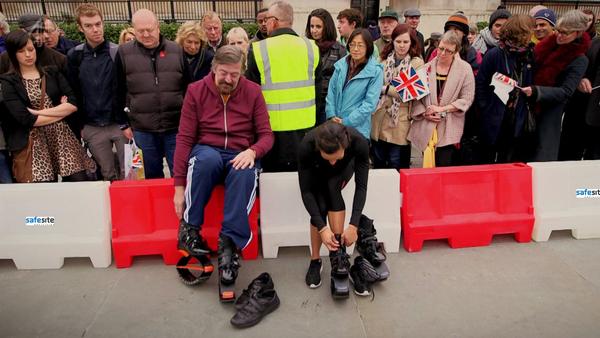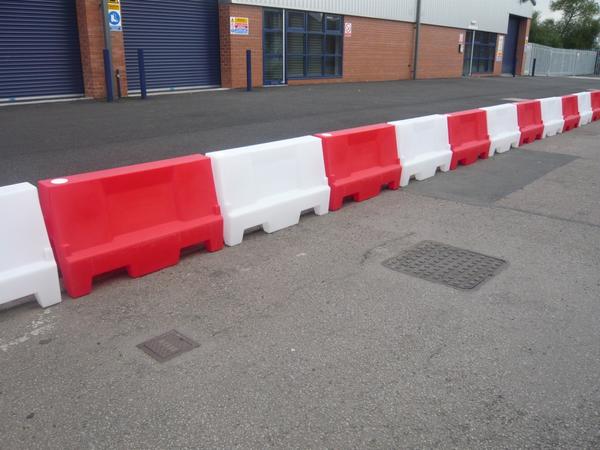- Next day delivery
- Installation service available
- Buy back on all products
- Rated Excellent
When to Use Water Filled Barriers
Although concrete and metal grid barriers are best recognised as having a variety of uses within the UK, such as for directing traffic or crowd flow or creating barriers to designated areas, water filled barriers are fast catching on as a suitable alternative with a wide variety of use, but particularly for traffic flow and control, for example to:
- Close off sections of roads to traffic.
- Create highly visible, temporary edging to active traffic lanes, highlighting awareness of on-going works but reducing the risk of death from accidental impact with the barrier.
- Delineate diversions and exit or access ramps.
Constructed from tough, UV stabilized polythene, water filled barriers are generally lightweight and can be easily transported, moved and connected to each other, before being filled with water to give them weight, stability and an impressive strength against impact and accidental (or deliberate) misplacement.
Because of these qualities, water filled barriers are starting to become the alternative of choice for barriers required in traffic zones because of an additional feature which distinguishes them significantly from their concrete counterparts – they’re proving to be the safer option.

Minimising physical impact
Although temporary barriers to control traffic are safety essentials which allow road works and other construction work to take place on the UK’s roads whilst the roads themselves remain open, statistics show that concrete and metal barriers can present hazards of their own to construction workers, motorists, cyclists and pedestrians.
Studies into the mortality rates associated with barrier controls show that the G forces of hitting a concrete barrier offer a high risk of death and injury from the impact, particularly for motorists and their passengers when comparing the outcome of impact on a vehicle when hitting water filled barriers rather than concrete ones, particularly when issues of height and speed are taken into consideration.
No gaps in safety provision
As an alternative, to minimise risk of impact with concrete barriers, many construction companies, including those in road construction, use drums or traffic cones to delineate areas for traffic control. However, these bring their own risks, such as from that space between cones which can allow accidental (or deliberate) access through what is essentially a ‘virtual’ barrier.
Because of their easy and effective connectivity, water filled barriers can form a complete barrier without any gaps or spaces, affording additional safety and security for both construction workers and the public. They are also fitted with anti-tamper plugs which maximise protection against vandalism and theft, a common problem experienced when using cones.
Similarly, those spaced devices have an enhanced risk of being knocked out of place by passing vehicles or being misaligned and damaged by weather. Water filled barriers offer greater stability against impact or movement at an individual level, whilst their connectivity means that the chance of the delineation or direction being altered is minimal.

Maximising visual impact
It is well recognised that road awareness has a significant role to play in traffic and road-side construction safety. With their large size and ‘alert’ colours of red, orange and white offering good visibility at an effective sight distance, water filled barriers also enhance opportunities for making motorists aware of road works, diversions and closures as early as possible, allowing them to take appropriate action in plenty of time.
This is particularly important in areas where barriers are not necessarily expected. Recent data from Road Safety Foundation identified that the single carriage A roads of the UK are seven times more risky than the UK’s motorways over the period of 2007 to 2011. Reducing, not increasing, the risk of accidents in those higher risk areas should be a priority and choice of barrier type to one that can be easily visible against the roadside backdrop can make a real difference.
On both sides of the barrier
Whilst statistics show that there are higher incidences of accidents, injuries and fatalities in road work zones for drivers and their passengers, using effective barriers to control traffic isn’t just about what’s happening on the traffic side of the barrier. Whilst there’s an absolute need to protect vehicles and direct them safely away from works, barriers also have a role to play in positive protection for roadside workers.
Working alongside busy roads and motorways, workers are at risk from on-coming traffic, fumes and incidentals such as items being thrown from vehicles, stones and debris flying up from the ground, hurled at speed by vehicle wheels and, worst still, high speed vehicles themselves, breaching those gaps in stretches of cones. According to the UK’s Highways Agency, eight road workers died and over 300 were injured in the period between 2009 – 2013, with six of these deaths and 29 serious injuries occurring in 2010 alone, statistics which stand as a reminder of the vulnerability of workers on the roads.
Cones are recognised in offering minimum protection for work zones, but although concrete barriers are thought to offer maximum protection to workers they come with that increased risk of creating more fatalities for drivers who might crash into them, with over 100 incidents in road work areas in the year from April 2010 to March 2011.
As a safety essential, water filled barriers offer an excellent compromise of providing a physical barrier which offers both worker protection and reduced risk to drivers and their passengers in the event of accidents. With their tough barriers which can be interlocked to create straight lines as well as left and right curves, water filled barriers cross the divide between keeping road workers or road users safe, being built for purpose, fit for safety and minimising risk to those on either side of the barrier – whether passing the work zone or working as part of it.
Request a free no-obligation quote
We respond in under 30 mins on average (excl. weekends)